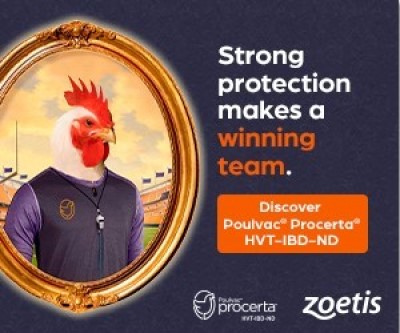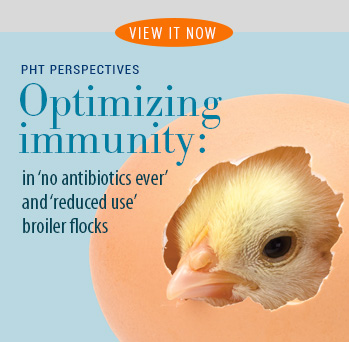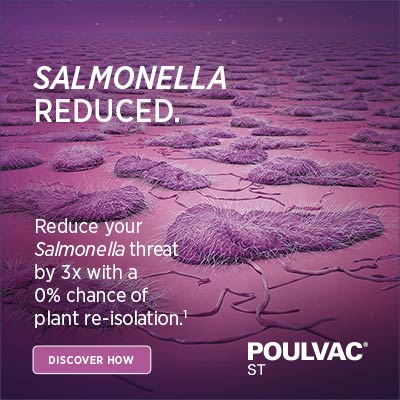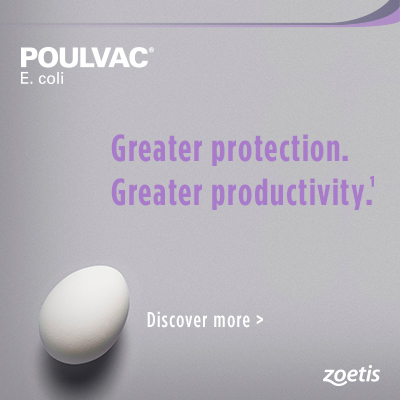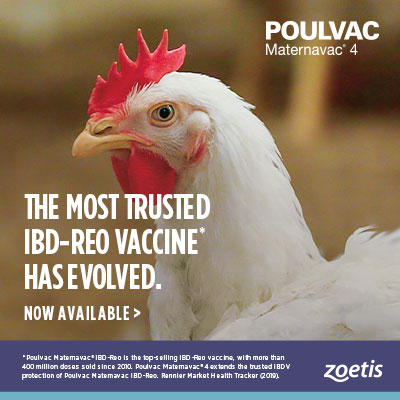Exploring the connection between hemorrhagic hepatopathy and inactivated vaccines used in broiler breeders

An interview with Andy McRee, DVM, Senior Technical Services Veterinarian, Zoetis
Q: There have been reports, either in the literature or anecdotal, about hemorrhagic hepatopathy associated with inactivated vaccines. What are the signs of this condition?
TL: There are several possible causes of hemorrhagic hepatopathy, but when it occurs after vaccination, it’s a random and unpredictable syndrome that shows up after use of an inactivated bacterin, such as a Salmonella vaccine. Birds may or may not have extensive reactions at the site of a vaccine injection. However, internal organs may hemorrhage, particularly the liver, which presents as enlarged and friable. Blood may be observed in the lumen of the intestinal tract. Bird mortality is often the only first sign. It spikes starting about 2 to 3 weeks after vaccination and can reach about 1% or more. Unfortunately, there’s no treatment.
Q: Does the type of inactivated vaccine — specifically, commercial or autogenous — have any impact on the incidence of hemorrhagic hepatopathy?
TL: Commercial Salmonella bacterins have been implicated in commercial egg layers. I am familiar with cases of hepatopathy occurring in broiler breeders after receiving the second dose of an autogenous Salmonella bacterin at 18 to 20 weeks of age.
Q: What then do you think causes the problem?
TL: There may be a hypersensitivity or allergic mechanism at work leading to the described reaction. Based on discussions I’ve had with scientists, it might have something to do with the amount of lipopolysaccharide left in the vaccine after centrifugation and “cleaning” of the vaccine. If a product is less “clean,” there could be more severe reactions.
Q: Could mishandling of inactivated vaccines, particularly overheating, contribute to the problem?
TL: This is uncertain. During several recent pullet vaccination evaluations, we did in fact find that overheating of inactivated vaccines — upwards of 110° F to 114° F (43° C to 45.5° C) — is an occurring problem in the field, but in these instances, hemorrhagic hepatopathy hadn’t occurred.
Q: Why are vaccines being overheated?
TL: Vaccination crews are typically using water baths to warm the vaccines. Many of these baths have no thermostat — or thermostats that don’t work — which prevents proper monitoring of the water temperature. If you use water baths, the water temperature should be maintained to minimize fluctuations and generally not exceed 95° F (35° C).
Q: Why do inactivated vaccines used in broiler breeders need to be warmed at all?
TL: Some manufacturers don’t recommend warming their inactivated vaccines, but most do. Many of the inactivated vaccines we use in long-lived birds are in an oil emulsion. Injecting them at low temperatures — 72° F (22° C) — has been associated with a strong tissue reaction.1
Warming — which is different from overheating — results in less reaction and minimizes injection-site reactions that can lead to condemnation of breast meat due to granulomatous lesions. It also reduces the emulsion’s viscosity, which makes it easier for the vaccine to flow through the syringe and needle and for the vaccine to disperse into the bird.
Q: Are there any consequences if inactivated vaccines are overheated?
TL: Inactivated vaccines are sensitive to temperature extremes. Overheating as well as letting them freeze can break the emulsion and negatively affect their efficacy. Overheating as well as injection of a vaccine that’s too cool can cause injections to be very uncomfortable for the bird, but overheated vaccines in particular may exacerbate or increase the severity of vaccine reactions.
Q: What are the proper temperatures for storing and injecting inactivated vaccines?
TL: Most inactivated vaccines should be stored under refrigeration at 35° F to 45° F (1.6° C to 7.2° C).
Always check the label, but the injection temperature generally should be from 85° F to 90° F (29.4° C to 32.2° C). The temperature of the vaccine should be checked with an instant-read cooking thermometer or an infrared temperature gun
Q: How can broiler breeder producers ensure they are properly managing temperatures for inactivated vaccines?
TL: Monitor temperatures. Remember that proper temperature management is crucial to get the best results with inactivated vaccines. Start with the right equipment. The refrigerator used for storage should be routinely checked to make sure it’s in good working order. If you use baths to warm these vaccines, monitor the water temperature. When it’s time to vaccinate, check the vaccine temperature before injection.
1 Burns E, et al. Evaluation of the effect of heating an oil-emulsion Pasteurella multocida bacterin on tissue reaction and immunity. Avian Dis. 2003 Jan-Mar;47(1):54-8.
TOOLBOX, Issue 9
Toolbox is a series of interviews with veterinarians and other technical specialists about their experiences managing antimicrobials, vaccines and other tools for poultry health. It is produced by the editors of Poultry Health Today on behalf of the US Poultry Business of Zoetis.
NA-01682
Jun 2018
Posted on February 11, 2019
 We’re glad you’re enjoying
We’re glad you’re enjoying






